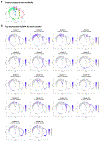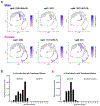Transcriptional control of the Cryptosporidium life cycle
- PMID: 38811723
- PMCID: PMC12057246
- DOI: 10.1038/s41586-024-07466-1
Transcriptional control of the Cryptosporidium life cycle
Abstract
The parasite Cryptosporidium is a leading agent of diarrhoeal disease in young children, and a cause and consequence of chronic malnutrition1,2. There are no vaccines and only limited treatment options3. The parasite infects enterocytes, in which it engages in asexual and sexual replication4, both of which are essential to continued infection and transmission. However, their molecular mechanisms remain largely unclear5. Here we use single-cell RNA sequencing to reveal the gene expression programme of the entire Cryptosporidium parvum life cycle in culture and in infected animals. Diverging from the prevailing model6, we find support for only three intracellular stages: asexual type-I meronts, male gamonts and female gametes. We reveal a highly organized program for the assembly of components at each stage. Dissecting the underlying regulatory network, we identify the transcription factor Myb-M as the earliest determinant of male fate, in an organism that lacks genetic sex determination. Conditional expression of this factor overrides the developmental program and induces widespread maleness, while conditional deletion ablates male development. Both have a profound impact on the infection. A large set of stage-specific genes now provides the opportunity to understand, engineer and disrupt parasite sex and life cycle progression to advance the development of vaccines and treatments.
© 2024. The Author(s), under exclusive licence to Springer Nature Limited.
Figures














References
-
- Striepen B. Parasitic infections: Time to tackle cryptosporidiosis. Nature 503, 189–191 (2013). - PubMed
MeSH terms
Substances
Grants and funding
LinkOut - more resources
Full Text Sources
Medical
Molecular Biology Databases

